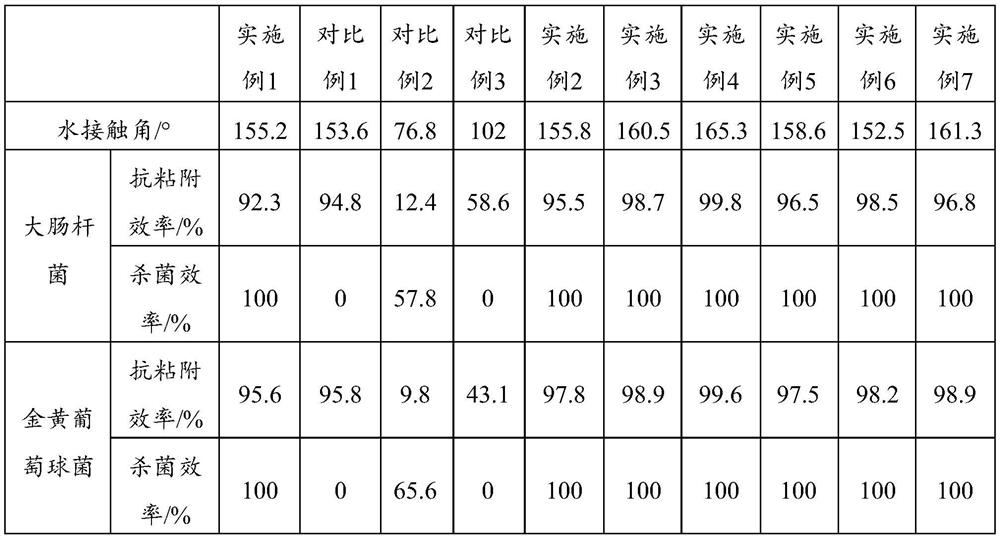Photodynamic superhydrophobic anti-infection coating and preparation method thereof
A super-hydrophobic, anti-infection technology, applied in water supply equipment, sanitary equipment for toilets, disinfection, etc., can solve problems such as the inability to prevent bacterial infection for a long time, the reduction of antibacterial persistence of the coating, and the easy dissolution of antibacterial active components. Achieve broad-spectrum and long-lasting antifouling and antibacterial effects, improve antibacterial performance, and reduce the risk of bacterial infection
- Summary
- Abstract
- Description
- Claims
- Application Information
AI Technical Summary
Problems solved by technology
Method used
Image
Examples
preparation example Construction
[0025] The invention provides a method for preparing a photodynamic superhydrophobic anti-infection coating, comprising the following steps:
[0026] a) in-situ depositing silicon dioxide on the surface of the base material to obtain the base material after surface treatment;
[0027] b) performing chemical bonding of a photosensitizer on the surface of the surface-treated base material obtained in step a), to obtain a material with a photosensitizer bonded to the surface;
[0028] c) performing fluorination treatment on the surface-bound photosensitizer obtained in step b) to obtain a photodynamic superhydrophobic anti-infection coating.
[0029] In the invention, silicon dioxide is deposited in situ on the surface of the base material to obtain the base material after surface treatment. In the present invention, the base material is preferably selected from polymer materials, fabric materials, glass or silicon wafers, more preferably fabric materials. In the present invent...
Embodiment 1
[0056] (1) Put the cellulose-containing cotton cloth material in a mixed solution of methanol, isopropanol, and ammonia water with a volume ratio of 20:75:18, add a total of 6 mL tetraethyl orthosilicate dropwise, and then The substrate was reacted for 6 hours, washed with ethanol and deionized water, and then dried to obtain a surface-treated base material.
[0057] (2) The base material after the surface treatment that step (1) obtains is placed in the APTES toluene solution that the volume ratio is 3%, and after normal temperature reaction 2h, immerse in advance 0.5h and mix and contain Ce6 (mass volume concentration is 20mg / mL), EDC (mass volume concentration is 50mg / mL) and NHS (mass volume concentration is 100mg / mL) in DMSO mixed solution for 24h, the pH value of the mixture is 5.5, followed by washing and drying to obtain surface bonded Materials for photosensitizers.
[0058] (3) Place the surface-bonded photosensitizer material obtained in step (2) in an anhydrous t...
Embodiment 2
[0068] (1) Put the cellulose filter paper in the mixed solution of methanol, isopropanol and ammonia water with a volume ratio of 25:75:20, add a total of 6mL tetraethyl orthosilicate dropwise, and then react at room temperature for 8h , and then washed with ethanol and deionized water and then dried to obtain a surface-treated base material.
[0069] (2) Place the base material after the surface treatment that step (1) obtains in the APTES toluene solution that the volume ratio is 1%, after normal temperature reaction 12h, immerse into the mixture that contains Ce6 (mass volume concentration is 30mg) in advance 0.5h / mL), EDC (mass volume concentration is 50mg / mL) and NHS (mass volume concentration is 100mg / mL) in DMSO mixed solution for 12h, the pH value of the mixture is 6, followed by washing and drying to obtain surface bonded Materials for photosensitizers.
[0070] (3) Place the surface-bonded photosensitizer material obtained in step (2) in an anhydrous toluene soluti...
PUM
| Property | Measurement | Unit |
|---|---|---|
| water contact angle | aaaaa | aaaaa |
Abstract
Description
Claims
Application Information
 Login to View More
Login to View More - R&D Engineer
- R&D Manager
- IP Professional
- Industry Leading Data Capabilities
- Powerful AI technology
- Patent DNA Extraction
Browse by: Latest US Patents, China's latest patents, Technical Efficacy Thesaurus, Application Domain, Technology Topic, Popular Technical Reports.
© 2024 PatSnap. All rights reserved.Legal|Privacy policy|Modern Slavery Act Transparency Statement|Sitemap|About US| Contact US: help@patsnap.com








